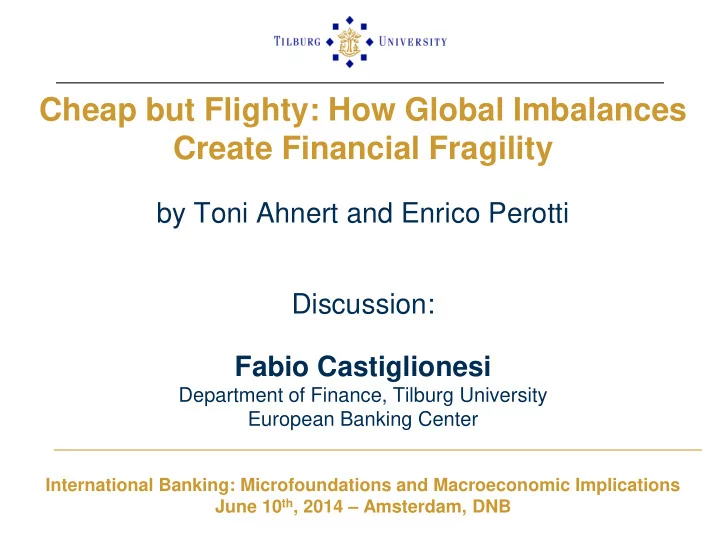

Cheap but Flighty: How Global Imbalances Create Financial Fragility by Toni Ahnert and Enrico Perotti Discussion: Fabio Castiglionesi Department of Finance, Tilburg University European Banking Center International Banking: Microfoundations and Macroeconomic Implications June 10 th , 2014 – Amsterdam, DNB
Aim of the Paper • To explain instability in developed countries. • To provide micro foundations of the relevant channel. 2
General Assessment • Understanding the reasons behind the financial fragility shown by developed countries is clearly relevant. • The effort to focus on the crucial role played by investors in developing countries (“saving glut”) is also really worth it! 3
Summing up: Approach • The model emphasizes safety over contingent liquidity needs (Diamond and Dybvig, 1983). • This shift is motivated by the evidence from the recent crisis. 4
Summing up: Features • Main features about foreign investors: 1.Face political risk. 2.Have less information than domestic investors on “local” asset risk. 3.Have a preference for absolute safety. 5
Summing up: Model (I) • Basic trade off: Foreign investors provide cheap funding (political risk) but expose to run the developed country even when solvent (uninformed). • Without absolute safety, the optimal contract is long term debt to all investors (mutual fund). Inefficient investment can arise but no fragility. 6
Summing up: Model (II) • With absolute safety the optimal contract is: • Foreign investors choose short term debt; • Domestic investors choose long term debt. • Domestic insure foreign: they suffer losses in case of a run in exchange of an higher return. Fragility is a feature of the optimal contract. 7
Comments (I) • Political risk in developing country as main motivation to invest in developed country. • My prior: Sovereign funds are the main driver of the saving glut (China, Singapore, Middle-east countries...). No clear political risk for them. 8
Comments (I) • However… Badarinza and Ramadorai (2014) show effects of political risk in housing market. • Can we know more on how much the investment flow is due to sovereign funds and private investors? 9
Comments (II) • The asymmetric information about the domestic asset deserve more attention. • The asset we are talking is US T-bill. Is it realistic? • The supportive literature (Petersen and Rajan, 2002) seems not appropriate. 10
Comments (III) • Extreme form of risk aversion is needed. • Foreign investors obtain consumption investing only in the foreign asset D. • Consumption is determined from total wealth (TW = D + Equity + Human Capital). 11
Comments (III) • It would be reasonable to assume extreme risk aversion on the return of total wealth. • Assume TW = D + E. (E has a continuum of realizations.) Then TW is defined on “normal” preferences. Result: risk neutral on TW and extreme risk averse on D. Is this consistent? 12
Minor Comments • Highlight better the difference with Gennaioli, Shlaifer and Vishny (2011, 2013) • Why needed political risk? Why is not assuming (directly) absolute safety preferences? 13
Conclusions • The paper addresses a very important issue. • It is very clear, and well written. • Authors are also making an analysis with endogenous safety rents. • Big question: Can we shed light on WHY (endogenously) there is safety seeking? 14
Thank you for your attention! 15
Recommend
More recommend